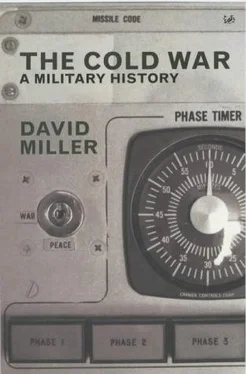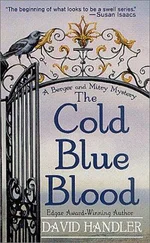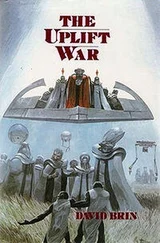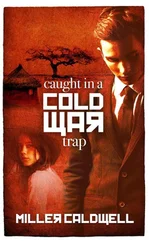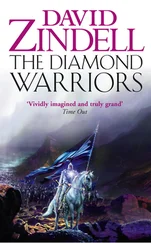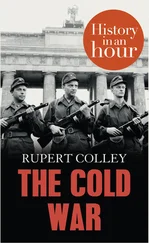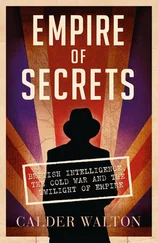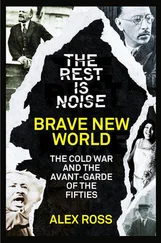Earlier in the year (18 April 1983) Catholic bishops in West Germany had issued a similar pastoral letter, in which they stated that nuclear weapons were a necessary but regrettable method of maintaining peace in Europe.
In 1946 the three western Allied commanders-in-chief exchanged liaison missions with their Soviet opposite number. Such missions continued until the end of the Cold War.
‘Snow’ is a form of radar jamming created by a combination of electronic means and aircraft dropping short strips of metal foil.
The author was serving in Germany at the time and well remembers that virtually every unit was at a very low state of readiness, since August was, by custom, the period when summer holidays were taken. Most units were thus down to the absolute minimum manpower permitted under NATO rules, and many of the troops theoretically ‘present’ on duty had been sent away on official training and would have taken several days to return to barracks before starting deployment.
An intermediate-range ballistic missile (IRBM) was a land-based missile with a range between 1,500 nautical miles (2,780 km) and 3,000 nautical miles (5,560 km).
A 1 MT (1 megaton) warhead is equivalent to 1 million tons of TNT; a 1 kT (1 kiloton) warhead is equivalent to 1,000 tons of TNT – see Chapter 7 7 The Nature of Nuclear War HANGING OVER EVERY political and military decision throughout the Cold War was the threat of atomic and, later, of thermonuclear attack. This dreadful prospect faced politicians, the military and civil populations alike, and as much in neutral countries as in those involved in any possible conflict. As with many such issues, however, the majority were aware only of an appalling, but vague, Doomsday threat; indeed, as will be shown, even the so-called ‘experts’ could make only imprecise forecasts of what it would involve. It is therefore necessary to identify the major characteristics of nuclear weapons and to highlight some of their possible effects, in order to place the subsequent chapters in perspective. [1]
.
Mach 1 is the speed of sound, which is approximately 1,200 km/h at sea level, but varies with temperature and pressure.
Pershing I, the original version, was carried on a tracked launcher. The Pershing IA system consisted of the same missile but mounted on a wheeled launcher, enabling it to be carried in a C-130 Hercules transport aircraft.
The chief-of-staff was the senior serving military officer in the national armed forces – i.e. Chairman of the Joint Chiefs-of-Staff (US), Chief of the Defence Staff (UK), etc. When the chiefs-of-staff attended in person, the committee was designated the NATO Military Committee in Chiefs-of-Staff Session.
The top rank structure and the NATO ‘star’ system are explained in Appendix 4.
A full list of NATO and Warsaw Pact commanders-in-chief is in Appendix 5.
To this day (1998) there is a large UK military staff in Washington and a slightly smaller US staff in London who continue to provide this unique ‘Anglo-Saxon’ link.
As always, there were exceptions to every rule. Thus, Commander UK Air Forces was actually known (incorrectly) as CINCUKAIR and, although an MSC, reported direct to SACEUR and not through a PSC. Similarly, Commander-in-Chief Channel (CINCHAN), although nominally a PSC, was actually treated as an MNC – an anomaly which ceased after the end of the Cold War.
This command was intended to be the operational headquarters for US navy long-range anti-submarine warfare (ASW) aircraft, which would be allocated in war.
It did not become fully operational until March 1953.
UKAIR was also unusual in that it was the only single-service (i.e. all air force), single nation MSC.
PTT (Post, Telephone, Telegraph) was the generic term for the telecommunications agencies, which almost to the end of the Cold War were government-owned – e.g. the Bundespost (West Germany) and the General Post Office (UK).
Infrastructure-funded projects were paid for out of a commonly agreed annual NATO budget; the only alternative source of funding was national.
A NATO IV system was ordered in the late 1980s but did not come into service until after the Cold War had ended.
ACE HIGH was built at a time when France was part of the integrated military structure and several stations were, therefore, on French territory. The French continued to provide a full service at these stations through to the end of the Cold War and beyond.
The text of the Warsaw Treaty is given in Appendix 3.
A full list of both Warsaw Pact and NATO commanders-in-chief is given in Appendix 5.
Note that Soviet ‘armies’ were equivalent in size and combat power to a NATO ‘corps’.
All Warsaw Pact aircraft taking part in the operation had red stripes around their rear fuselage and on their wings, to differentiate them from Czech aircraft.
Rokossovsky had been imposed as minister of national defence by the USSR in 1949. Following his dismissal in 1958 he was replaced by a Polish general and then returned to Moscow and retirement.
In 1982 the Soviets and East Germans started work on a totally new port at Neu Mukran on Rügen island. This was intended as a safeguard against future disruption of the overland route through Poland; however, such a sea route would have been disrupted by ice in winter and would have been very vulnerable to hostile action in war.
There were occasional command-post exercises in the mid-1980s.
It was classified by the Romanian navy, with typical exaggeration, as a ‘battlecruiser’.
A list of nuclear-weapons ‘firsts’ is given in Appendix 6.
Trinitrotoluene (TNT) is the ‘standard’ chemical high explosive.
For practical purposes, this means that the bottom edge of the fireball is 20 m above ground level.
Ambient pressure is approximately 1 kgf/cm 2.
Ground zero (GZ) is the point on the earth’s surface vertically above or below the centre of a nuclear explosion. At sea, the equivalent is surface zero (SZ).
Two units are used to measure radiation: the roentgen measures exposure and the rad measures absorption. For the purposes of this book, the two are essentially synonymous (i.e. 1 roentgen = 1 rad) and the rad will be used. The absorbed radiation can be expressed either as a dose rate (rads per hour) or as an accumulated figure (total rads over a specified time). To confuse matters further, NATO recently redesignated the rad as the Grey , but, since it was the term commonly used throughout the Cold War, the term rad will be used here.
The main NATO communications system in Europe, designated ACE HIGH, used tropospheric scatter, whose value in the aftermath of a series of nuclear explosions would have been questionable, to say the least.
Читать дальше
